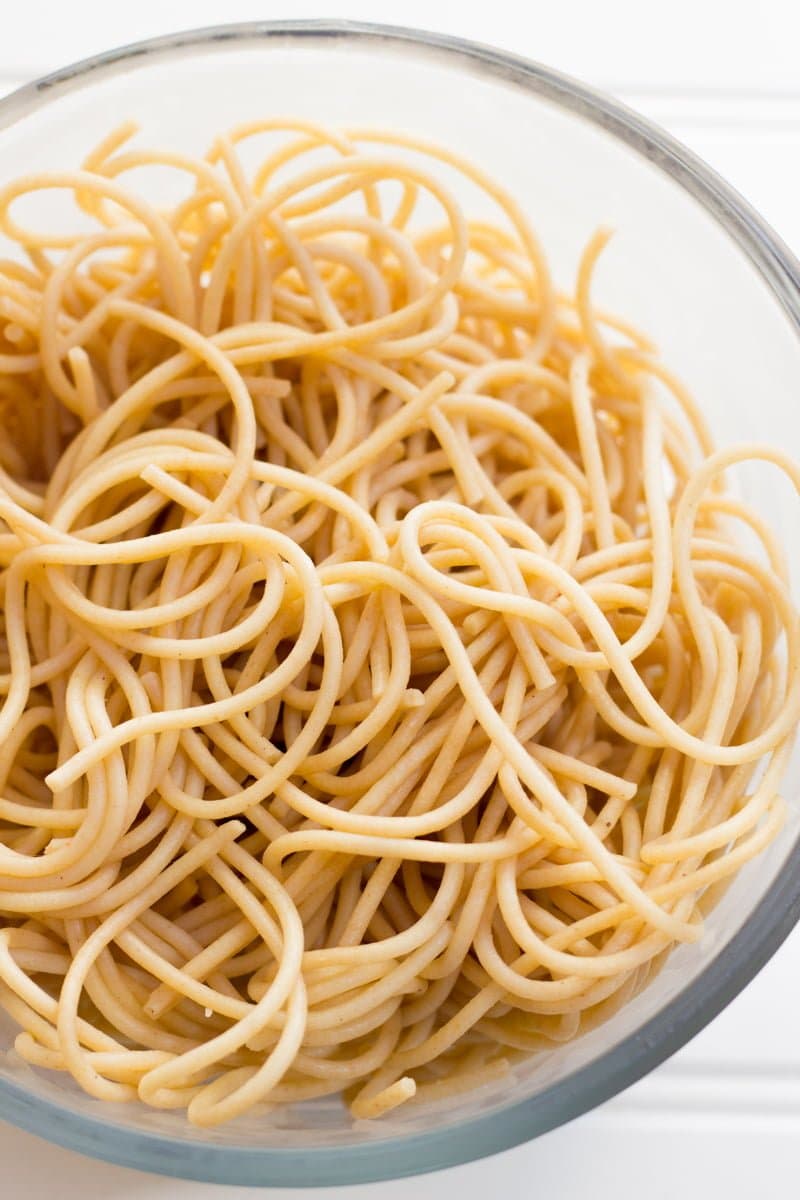You know what I’m terrible at? Measuring pasta. I can never get it right. I always cook way too much or way too little. I know they have little spaghetti measuring gadgets, but my problem goes way beyond just one style of pasta. Penne, macaroni, angel hair—I’m horrible at estimating all of it.
Since cooking too little pasta is mega annoying (because by the time you realize it’s too little, you’ve already dumped the boiling water and have to boil another pot—ugh), I like to err on the side of cooking too much. Which means there is a pretty constant supply of leftover pasta stashed in my fridge.

Sometimes I’ll just heat it up with a little sauce or pesto and call it good, but I also like to repurpose the pasta into something new and exciting—like this leftover spaghetti frittata.

If we have spaghetti for dinner, it’s a pretty safe bet we’re eating this frittata for breakfast the next day. I like it best with spaghetti, but it will work with whatever pasta you have kicking around. In the summer (or in fall, when we’re lucky enough to not have had a frost yet), I’ll use fresh, Italian herbs—parsley, oregano, and basil—and fresh tomatoes. During the winter months, I’ll pull out my dried herbs and use some sundried tomatoes. Both ways are absolutely delicious! The great joy of a frittata is that you can pretty much throw in whatever you have in the kitchen, and it almost always turns out spectacular. It’s a great dish if you want to try to get into more of seasonal cooking—use what you have.
Frittatas are also a great option for lunches. Make up a frittata on the weekend, cut it into small slices, and pack it into containers for healthy easy lunches throughout the week. I happily eat leftover frittata cold or at room temp (but you can also nuke it if you’d rather enjoy it warm).
 I always make frittatas in my old, well-seasoned cast iron skillet. I absolutely love cooking in cast iron because it holds heat so evenly, it transfers seamlessly from the stovetop to the oven, and it also helps increase the iron levels of the food that is cooked in it. If I was told I could only use one pan for the rest of my life, I’d pick my cast iron skillet!
I always make frittatas in my old, well-seasoned cast iron skillet. I absolutely love cooking in cast iron because it holds heat so evenly, it transfers seamlessly from the stovetop to the oven, and it also helps increase the iron levels of the food that is cooked in it. If I was told I could only use one pan for the rest of my life, I’d pick my cast iron skillet!
Enjoy!

Leftover Spaghetti Frittata
Have some pasta kicking around your fridge from last night's dinner? Use it to make this Italian-flavored leftover spaghetti frittata.
Ingredients
- 1 tablespoon olive oil
- 1/2 teaspoon fennel seeds
- Pinch red pepper flakes
- 1 medium onion, diced
- 2 clove garlic, minced
- 1 large tomato, diced
- 1/2 cup milk
- 4 eggs
- 1/3 cup grated Parmesan
- 1/2 teaspoon salt
- 1/2 teaspoon black pepper
- 4 cups cooked pasta
- 2 tablespoons fresh, minced oregano (or 1 1/2 teaspoons dried)
- 2 tablespoons fresh, minced parsley (or 1 1/2 teaspoons dried)
- 2 tablespoons fresh, minced basil (or 1 1/2 teaspoons dried)
Instructions
- Preheat oven to 425°. Heat the olive oil over medium-high in a medium-sized oven-proof skillet. Add in the fennel seeds, red pepper flakes, onion, and garlic. Cook until onion and garlic are fragrant and tender, about five minutes. Add in the tomato and cook until some of the water is released, about 2 minutes.
- Meanwhile, whisk together the milk, eggs, Parmesan, salt, and pepper until light and frothy.
- Add the leftover pasta to the tomato mixture, and stir until evenly distributed. Spread the mixture evenly along the bottom of the skillet.
- Pour the egg mixture over top of the spaghetti mixture—do not stir. Reduce the heat to medium-low, and cook until the edges of the frittata are solid, but the top is still liquidy, about 5 minutes.
- Sprinkle top with herbs, and place frittata in the oven to finish setting up. Frittata is done with the top is no longer liquid and it begins to brown. Remove from oven, and let cool for five minutes before slicing.
Nutrition Information:
Yield: 4 Serving Size: 1 servingAmount Per Serving: Calories: 373Total Fat: 12gSaturated Fat: 4gTrans Fat: 0gUnsaturated Fat: 7gCholesterol: 196mgSodium: 507mgCarbohydrates: 47gFiber: 4gSugar: 3gProtein: 18g
At Wholefully, we believe that good nutrition is about much more than just the numbers on the nutrition facts panel. Please use the above information as only a small part of what helps you decide what foods are nourishing for you.

